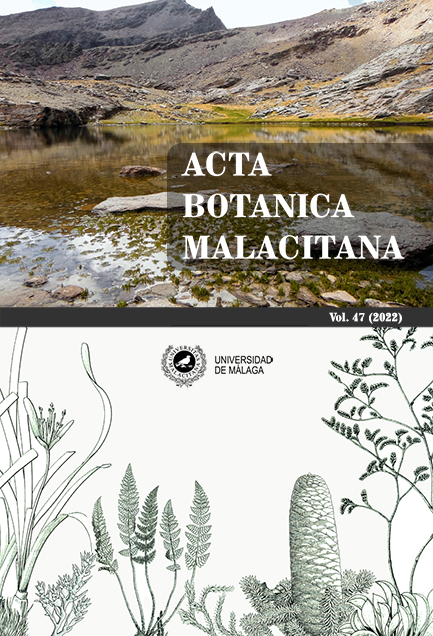New reports of Taraxacum F.H. Wigg. (Asteraceae) for the iberian flora
DOI:
https://doi.org/10.24310/abm.v47i.14725Keywords:
Dandelions, distribution, Iberian Peninsula, Taraxacum, taxonomyAbstract
Taraxacum boekmanii Borgv. and T. subhamatum M.P. Christ. are reported for the first time in Spain, and T. pinto-silvae Soest in Gredos mountains (Avila). From each of them, taxonomic characters with supplementary pictures are provided.
Downloads
Metrics
References
Dudman, A.A. & Richards, A.J. (1997). Dandelions of Great Britain and Ireland. London: Botanical Society of the British Isles.
Franco, J.A. & Rocha Afonso, M.L. (1984). Taraxacum Weber. In J.A. Franco (Ed.), Nova flora de Portugal, Vol. II (pp. 522-534). Lisboa: Sociedade Astória.
Galán de Mera, A. (2017). Taraxacum F.H. Wigg. [nom. cons.]. In S. Castroviejo (Coord.), Flora iberica Vol. XVI (II) (pp. 963-1062). Madrid: Real Jardín Botánico, CSIC.
Galán de Mera, A., Linares-Perea, E. & Vicente-Orellana, J.A. (2017). Taraxacum (Asteraceae) in the Azores, Madeira and the Canary Islands. Annales Botanici Fennici, 54, 273-285. https://doi.org/10.5735/085.054.0610
Kirschner, J. & Št?pánek, J. (1997). A nomenclatural checklist of supraspecific names in Taraxacum. Taxon, 46, 87-98. https://doi.org/10.2307/1224294
Kirschner, J. & Št?pánek, J. (2004). New sections in Taraxacum. Folia Geobotanica, 39, 259-274. https://doi.org/10.1007/BF02804781
Kirschner, J., Štepánek, J. & Greuter, W. [2007+]. Taraxacum. In: W. Greuter & E. Von Raab-Straube (Eds): Compositae. Euro+Med Plantbase - the information resource for Euro-Mediterranean plant diversity. Recurso electrónico en https://www.emplantbase.org/home.html. Consulta realizada el 06/04/2022.
Matysiak, J.P., Tison, J.M. & Ferrez, Y. (2014). Taraxacum F.H. Wigg. In J.M. Tison & B. De Foucault (Coords.), Flora Gallica. Flore de France (pp. 477-508). Mèze: Biotope Éditions.
Øllgaard, H. (1983). Hamata, a new section of Taraxacum (Asteraceae). Plant Systematics and Evolution, 141, 199-217. https://doi.org/10.1007/BF00989002
Richards, A.J. (1985). Sectional nomenclature in Taraxacum (Asteraceae). Taxon, 34(4), 633-644. https://doi.org/10.2307/1222201
Richards, A.J. (1992). The Taraxacum flora of the Sierra de Guadarrama and its surroundings (Spain). Anales del Jardín Botánico de Madrid, 50(2), 201-208.
Richards, A.J. (2003). Apomixis in flowering plants: an overview. Philosophical Transactions of the Royal Society B, 358, 1085-1093. https://doi.org/10.1098/rstb.2003.1294
Richards, A.J. (2012). Taraxacum section Hamata. Plant Crib, 3, 1-10.
Silvertown, J. (2008). The evolutionary maintenance of sexual reproduction: Evidence from the ecological distribution of asexual reproduction in clonal plants. International Journal of Plant Sciences, 169, 157-168. https://doi.org/10.1086/523357
Soest, J.L. (1956). Nouvelle contribution pour la connaissance des Taraxaca du Portugal. Agronomia Lusitana, 18(2), 94-98.
Št?pánek, J. & Kirschner, J. (2022). Taraxacum sect. Erythrocarpa in Europe in the Alps and eastwards: A revision of a precursor group of relicts. Phytotaxa, 536(1), 7-52. https://doi.org/10.11646/phytotaxa.536.1.2
Trávní?ek, B. & Vašut, J. (2011). Notes on the genus Taraxacum in Slovakia. I. Taraxacum sect. Hamata: a new group of dandelions in Slovakia. Biologia, 66(4), 595-603. https://doi.org/10.2478/s11756-011-0058-6
Uhlemann, I. (2003). Die Gattung Taraxacum (Asteraceae) im östlichen Deutschland. Sonderheft: Mitteilungen zur floristichen Kartierung in Sachsen-Anhalt.
Van Baarlen, P., Van Dijk, P.J., Hoekstra, R.F. & De Jong, J.H. (2000). Meiotic recombination in sexual diploid and apomictic triploid dandelions (Taraxacum officinale L.). Genome, 43, 827-835. https://doi.org/10.1139/g00-047.
Vašut, J. (2003). Taraxacum sect. Erythrosperma in Moravia (Czech Republic): Taxonomic notes and the distribution of previously described species. Preslia, 75, 311-338.
Downloads
Published
How to Cite
Issue
Section
License
All information related to the licensing of published works in Acta Botanica Malacitana and copyright can be found in our Editorial Policy.







1.png)
